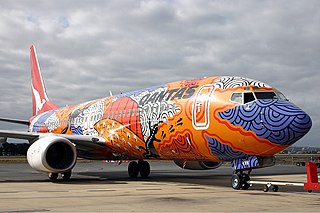
The Pitjantjatjara are an Aboriginal people of the Central Australian desert near Uluru. They are closely related to the Yankunytjatjara and Ngaanyatjarra and their languages are, to a large extent, mutually intelligible.

Mutitjulu is an Aboriginal Australian community in the Northern Territory of Australia located at the eastern end of Uluṟu. It is named after a knee-shaped water-filled rock hole at the base of Uluṟu, and is located in the Uluṟu-Kata Tjuṯa National Park. Its people are traditional owners and joint managers of the park with Parks Australia. At the 2011 census, Mutitjulu had a population of 296, of which 218 (71.2%) were Aboriginal.

Aṉangu is the name used by members of several Aboriginal Australian groups, roughly approximate to the Western Desert cultural bloc, to describe themselves. The term, which embraces several distinct "tribes" or peoples, in particular the Ngaanyatjarra, Pitjantjatjara and Yankunytjatjara groups, is pronounced with the stress on the first syllable:.
Australian Aboriginal astronomy is a name given to Aboriginal Australian culture relating to astronomical subjects – such as the Sun and Moon, the stars, planets, and the Milky Way, and their motions on the sky.

Aṉangu Pitjantjatjara Yankunytjatjara, also known as APY, APY Lands or the Lands, is a large, sparsely-populated local government area (LGA) for Aboriginal people, located in the remote north west of South Australia. Some of the Aṉangu (people) of the Western Desert cultural bloc, in particular Pitjantjatjara, Yankunytjatjara and Ngaanyatjarra peoples, inhabit the Lands.
Indulkana is an Aboriginal community in the Anangu Pitjantjatjara Yankunytjatjara Lands in South Australia, comprising one of the six main communities on "The Lands". At the 2016 Australian census, Indulkana had a population of 256.
The Ngaanyatjarra, Pitjantjatjara and Yankunytjatjara Women's Council is a community-based community organisation formed in 1980 delivering services to the Ngaanyatjarra, Pitjantjatjara and Yankunytjatjara women in the central desert region of Australia across the borders of the Northern Territory, South Australia, Western Australia with its headquarters in Alice Springs. It provides a range of community, family, research and advocacy services.
Jimmy Donegan is an Aboriginal Australian artist. His painting Papa Tjukurpa munu Pukara won the National Aboriginal & Torres Strait Islander Art Award in 2010. He speaks Pitjantjatjara and Ngaanyatjarra. His work is held in several major private galleries in Australia and Europe; the only major public gallery to hold one of his works is the National Gallery of Victoria.

Rene Kulitja, also known as Wanuny Kulitja, is an Aboriginal Australian artist. She works with a range of media, including paint, glass and ceramics. Her most famous design is probably Yananyi Dreaming, which covers a Qantas Boeing 737.
Tjayanka Woods is an Australian Aboriginal artist. She was one of the pioneers of the art movement across the Ngaanyatjarra, Pitjantjatjara and Yankunytjatjara lands, which began in 2000. She is best known for her paintings, but also a craftswoman who makes baskets and other woven artworks. Her paintings are held in the Art Gallery of Western Australia, National Gallery of Victoria, and the National Gallery of Australia.
Eileen Yaritja Stevens was an Aboriginal artist from central Australia. Although she had brief career of less than four years, she quickly became one of the most successful artists of her generation to paint in the style of the Western Desert. Her work is now held in several major public art collections across Australia.
Imiyari "Yilpi" Adamson is an Aboriginal artist from central Australia. She is known for her work in a range of art forms, including painting, sculpture, weaving, knitting and batik.
Robin Kankapankatja is an Australian Aboriginal artist. He worked for most of his life as a labourer and conservationist. He is the manager and senior traditional owner of Walalkara, a homeland and Indigenous protected area on the Aṉangu Pitjantjatjara Yankunytjatjara Lands. He began work as an artist in 2004, aged in his 70s. His artworks are now held in several major galleries in Australia.
Ngangkari are the traditional healers of the Anangu, the Aboriginal peoples who live mostly in the Anangu Pitjantjatjara Yankunytjatjara of South Australia and the Western Desert region, which includes parts of the Northern Territory and Western Australia. The word in the Arrernte languages of Central Australia is ngangkere. Ngangkari have been part of Aboriginal culture for thousands of years, and attend to the physical and psychic health of Anangu.
Maringka Tunkin is a Pitjantjatjara artist from Central Australia.
Pantjiti Unkari McKenzie is a senior Pitjantjatjara woman from the Anangu Pitjantjatjara Yankunytjatjara (APY) Lands. She has worked as an artist, film maker, actor, teacher, oral historian and recorder of cultural heritage, Ngangkari and as a senior law woman in her community. In 2019, she was awarded the Order of Australia Medal for her “service to the Indigenous community of the Northern Territory”.
Yaritji Young is a Pitjantjatjara woman from Pukatja, a community within the Anangu Pitjantjatjara Yankunytjatjara Lands and she now lives at Rocket Bore; a homeland north of Amata. Young is a significant Australian Aboriginal artist and senior law women who is to committed to fostering law and culture and this forms a core part of her artistic practice. Most of Young's paintings are drawn from the Tjala Dreaming.
Tuppy Ngintja Goodwin is an Aboriginal Australian artist from South Australia. She is a painter, and director of Mimili Maku Arts.
Nyurpaya Kaika Burton OAM is an artist and educator from the Anangu Pitjantjatjara Yankunytjatjara Lands of Central Australia.
Betty Muffler is an Aboriginal Australian artist and ngangkari (healer). She is a senior artist at Iwantja Arts, in Indulkana in Aṉangu Pitjantjatjara Yankunytjatjara, South Australia, known for a series of works on large linen canvases called Ngangkari Ngura .





